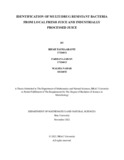| dc.contributor.advisor | Monjurul Haque, Fahim Kabir | |
| dc.contributor.advisor | Ahmed, Akash | |
| dc.contributor.author | Abanti, Rifah Tasnia | |
| dc.contributor.author | Jahan, Farhana | |
| dc.contributor.author | Nahar, Maliha | |
| dc.date.accessioned | 2023-07-23T06:31:26Z | |
| dc.date.available | 2023-07-23T06:31:26Z | |
| dc.date.copyright | 2022 | |
| dc.date.issued | 2022-11 | |
| dc.identifier.other | ID: 17326011 | |
| dc.identifier.other | ID: 17326013 | |
| dc.identifier.other | ID: 18126052 | |
| dc.identifier.uri | http://hdl.handle.net/10361/18968 | |
| dc.description | This thesis is submitted in partial fulfillment of the requirements for the degree of Bachelor of Science in Microbiology, 2022. | en_US |
| dc.description | Catalogued from PDF version of thesis. | |
| dc.description | Includes bibliographical references (pages 25-30). | |
| dc.description.abstract | Fruit juices are widely consumed in many tropical nations and are known for their high
nutritional value and mineral and vitamin content. In most cultures, fresh foods like fruits and
vegetables are a staple of the average person's diet and are consumed in considerable quantities.
The study aimed to detect the presence of pathogens in the fresh and packaged juices that the
mass people in Bangladesh are consuming. The presence of Escherichia coli, Salmonella,
Shigella, Klebsiella Pneumoniae selected from the family 'Enterobacteriaceae' and Listeria
monocytogenes, Pseudomonas, was the main focus of the study. Among the collected samples, 4
were industrially packaged juices, and four were locally made fresh juices collected from Dhaka
city. The samples were collected in sterile test tubes and subjected to total viable count (presence
of the targeted organisms) by spread plate method. Later, an antibiogram test was done against
ten commonly used antibiotics to determine the susceptibility of the targeted organisms. There
were 129 isolates collected from these samples. Among 129 isolated colonies, some notable ones
were Yersinia(28.0%), E.coli (8.0%), Enterobacter (6.0%), Salmonella spp (6.0%),
Shigella(2.0%), Vibrio (4.0%). Among 50 selected antibiotic-resistant bacteria, 30 MDR were
from the local fresh juices, and the rest 20 were collected from the packaged.
This study shows that there are significant medical implications when microorganisms develop
resistance to widely used antibiotics and medications. Our results confirmed the presence of
pathogens in the juices, significantly deteriorating public health. | en_US |
| dc.description.statementofresponsibility | Rifah Tasnia Abanti | |
| dc.description.statementofresponsibility | Farhana Jahan | |
| dc.description.statementofresponsibility | Maliha Nahar | |
| dc.format.extent | 30 pages | |
| dc.language.iso | en | en_US |
| dc.publisher | Brac University | en_US |
| dc.rights | Brac University theses are protected by copyright. They may be viewed from this source for any purpose, but reproduction or distribution in any format is prohibited without written permission. | |
| dc.subject | Zoonotic bacteria | en_US |
| dc.subject | pH | en_US |
| dc.subject | Antibiotic-resistant | en_US |
| dc.subject | Multidrug-resistant | en_US |
| dc.subject | Juice | en_US |
| dc.subject | Bacteriological load | en_US |
| dc.subject.lcsh | Drug resistance in microorganisms. | |
| dc.title | Identification of multi drug resistant bacteria from local fresh juice and industrially processed juice | en_US |
| dc.type | Thesis | en_US |
| dc.contributor.department | Department of Mathematics and Natural Sciences, Brac University | |
| dc.description.degree | B. Microbiology | |

